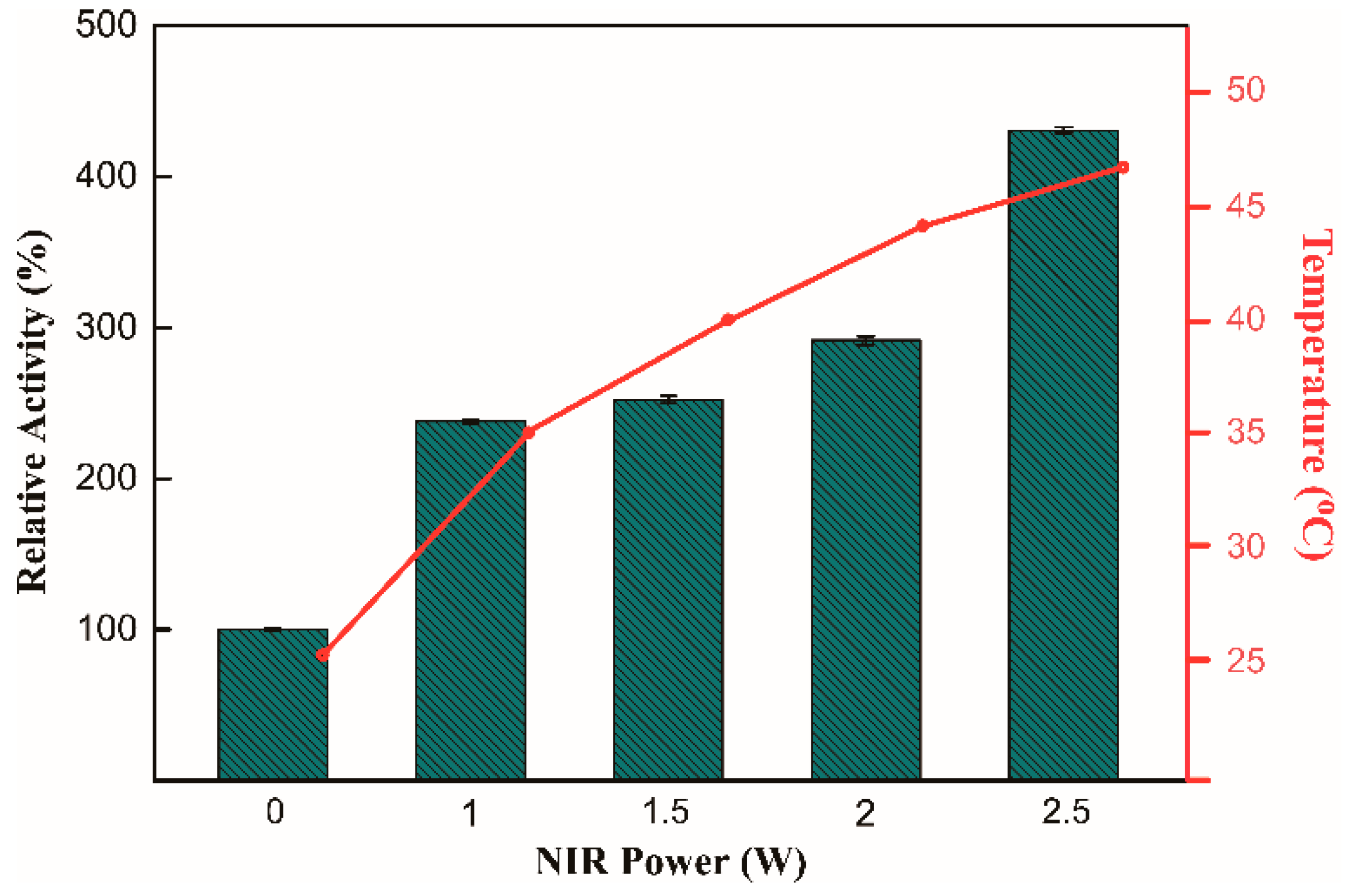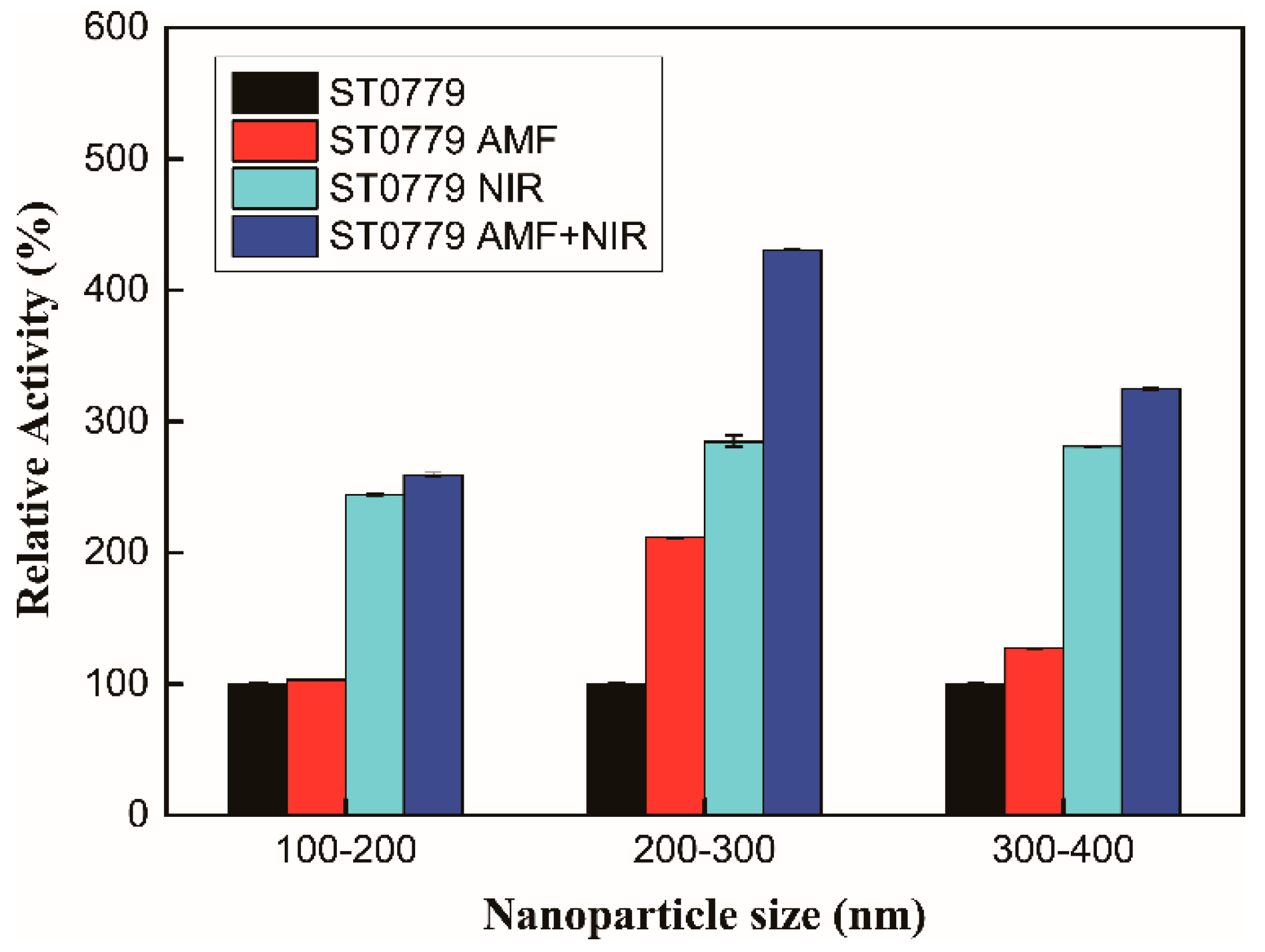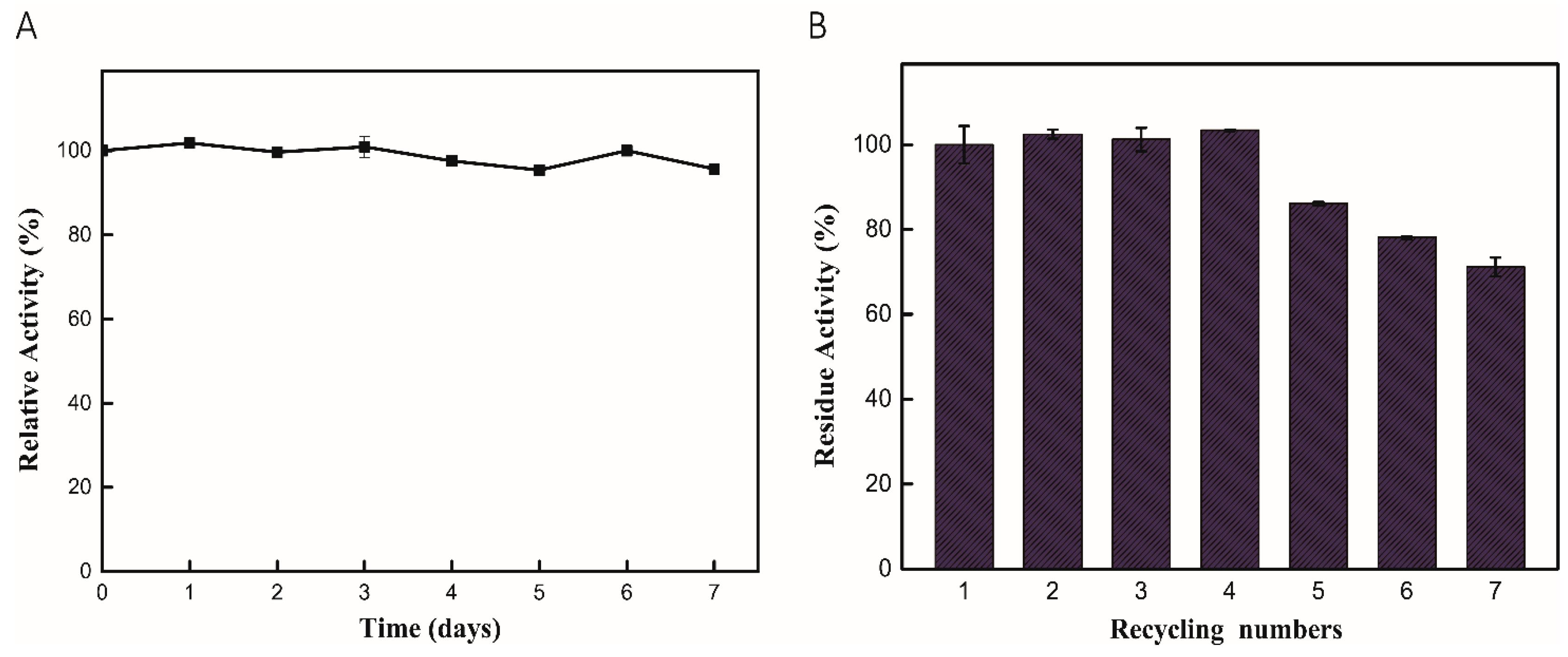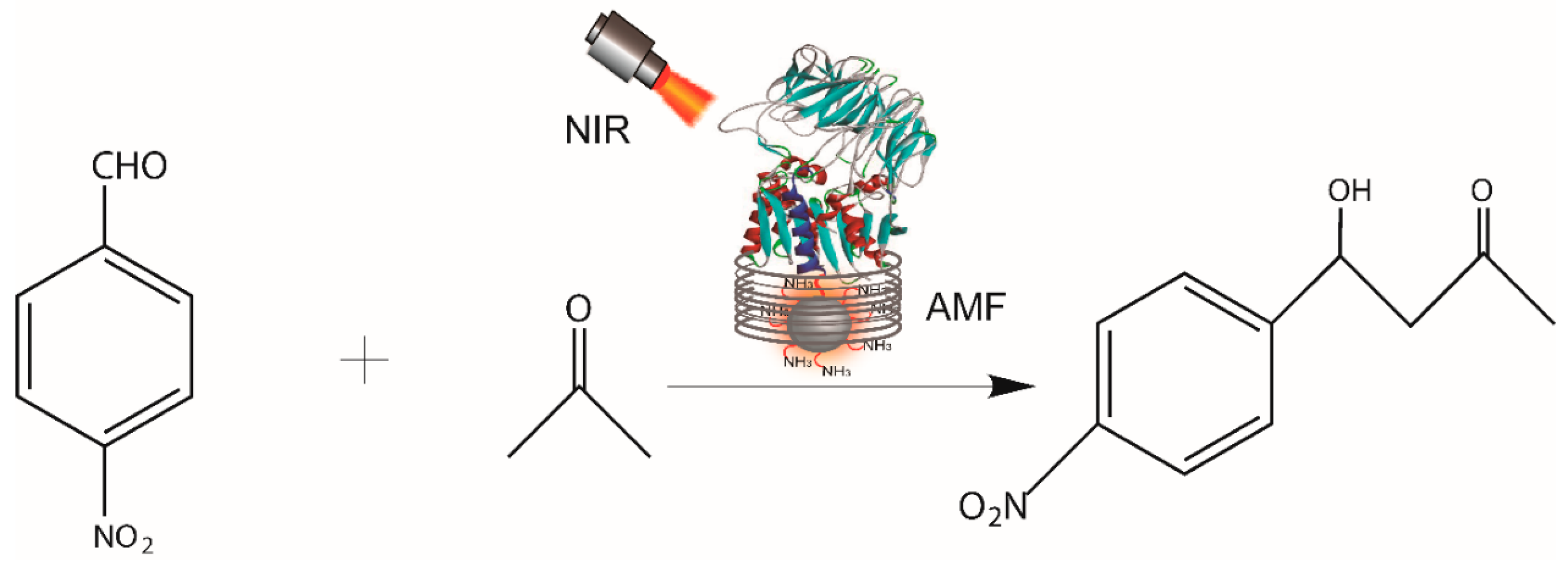Enhancement of Enzyme Activity by Alternating Magnetic Field and Near-Infrared Irradiation
Abstract
1. Introduction
2. Results and Discussion
2.1. Activation of Enzyme–Fe3O4 NC Under AMF and NIR
2.2. The Effect of Different Sizes of Fe3O4 on Enzyme Activity
2.3. Evaluation of Storage Stability and Reusability of ST0779-Fe3O4 Nanocomposites
2.4. Catalysis of ST0779-Fe3O4 Nanocomposites for Aldol Reaction
3. Materials and Methods
3.1. Materials and Chemicals
3.2. Expression of Recombinant Proteins
3.3. Immobilization of Enzyme
3.4. Enzyme Assay
3.5. Examination of Different Sizes of Fe3O4
3.6. Evaluation of Long-Term Stability and Recycling
3.7. Catalysis of Aldol Reaction
3.8. Statistical Analysis
4. Conclusions
Author Contributions
Funding
Data Availability Statement
Conflicts of Interest
Abbreviations
| NMs | Nanomaterials |
| NBS | Nano-biocatalytic system |
| NC | Nanocomposites |
| AMF | Alternating magnetic field |
| NIR | Near-infrared |
| MNPs | Magnetic nanoparticles |
References
- Scheibel, D.M.; Gitsov, I.P.I.; Gitsov, I. Enzymes in “Green” Synthetic Chemistry: Laccase and Lipase. Molecules 2024, 29, 989. [Google Scholar] [CrossRef] [PubMed]
- Intasian, P.; Prakinee, K.; Phintha, A.; Trisrivirat, D.; Weeranoppanant, N.; Wongnate, T.; Chaiyen, P. Enzymes, In Vivo Biocatalysis, and Metabolic Engineering for Enabling a Circular Economy and Sustainability. Chem. Rev. 2021, 121, 10367–10451. [Google Scholar] [CrossRef] [PubMed]
- Chen, Z.; Zhao, Y.; Liu, Y. Advanced Strategies of Enzyme Activity Regulation for Biomedical Applications. ChemBioChem 2022, 23, e202200358. [Google Scholar] [CrossRef] [PubMed]
- Rueda, N.; Dos Santos, J.C.S.; Torres, R.; Ortiz, C.; Barbosa, O.; Fernandez-Lafuente, R. Immobilization of Lipases on Heterofunctional Octyl–Glyoxyl Agarose Supports. Methods Enzymol. 2016, 571, 73–85. [Google Scholar] [PubMed]
- Khan, A.; Beg, M.R.; Waghmare, P. Intensification of Biokinetics of Enzymes Using Ultrasound-Assisted Methods: A Critical Review. Biophys. Rev. 2021, 13, 417–423. [Google Scholar] [CrossRef]
- Wang, F.; Liu, Y.; Du, C.; Gao, R. Current Strategies for Real-Time Enzyme Activation. Biomolecules 2022, 12, 599. [Google Scholar] [CrossRef] [PubMed]
- Zhao, X.; Chen, Y.; Niu, R.; Tang, Y.; Chen, Y.; Su, H.; Yang, Z.; Jing, X.; Guan, H.; Gao, R.; et al. NIR Plasmonic Nanozymes: Synergistic Enhancement Mechanism and Multi-Modal Anti-Infection Applications of MXene/MOFs. Adv. Mater. 2024, 36, 2307839. [Google Scholar] [CrossRef] [PubMed]
- Feng, W.; Yuan, J.; Gao, F.; Weng, B.; Hu, W.; Lei, Y.; Huang, X.; Yang, L.; Shen, J.; Xu, D.; et al. Piezopotential-Driven Simulated Electrocatalytic Nanosystem of Ultrasmall MoC Quantum Dots Encapsulated in Ultrathin N-Doped Graphene Vesicles for Superhigh H2 Production from Pure Water. Nano Energy 2020, 75, 104990. [Google Scholar] [CrossRef]
- Torres-Herrero, B.; Armenia, I.; Alleva, M.; Asín, L.; Correa, S.; Ortiz, C.; Fernández-Afonso, Y.; Gutiérrez, L.; De La Fuente, J.M.; Betancor, L.; et al. Remote Activation of Enzyme Nanohybrids for Cancer Prodrug Therapy Controlled by Magnetic Heating. ACS Nano 2023, 17, 12358–12373. [Google Scholar] [CrossRef]
- Zhang, Y.; Li, D.; Tan, J.; Chang, Z.; Liu, X.; Ma, W.; Xu, Y. Near-Infrared Regulated Nanozymatic/Photothermal/Photodynamic Triple-Therapy for Combating Multidrug-Resistant Bacterial Infections via Oxygen-Vacancy Molybdenum Trioxide Nanodots. Small 2021, 17, 2005739. [Google Scholar] [CrossRef]
- Jiao, W.; Zhang, T.; Peng, M.; Yi, J.; He, Y.; Fan, H. Design of Magnetic Nanoplatforms for Cancer Theranostics. Biosensors 2022, 12, 38. [Google Scholar] [CrossRef] [PubMed]
- Yang, Q.; Zou, Y.; Li, X.; Yang, L.; Zhang, B.; Wu, X. Waxberry-Shaped Biomimetic Nanoparticles for Efficient Photothermal Conversion. Int. J. Therm. Sci. 2024, 195, 108612. [Google Scholar] [CrossRef]
- Guimaraes, M.; Mateus, N.; de Freitas, V.; Branco, L.C.; Cruz, L. Microwave-Assisted Synthesis and lonic Liquids: Green and Sustainable Alternatives toward Enzymatic Lipophilization of Anthocyanin Monoglucosides. J. Agric. Food Chem. 2020, 68, 7387–7392. [Google Scholar] [CrossRef]
- Elabbadi, M.; Boukouvala, C.; Ringe, E. Controllable Synthesis of Pd and Pt Shells on Au Nanoparticles with Electrodeposition. Sci. Rep. 2025, 15, 1292. [Google Scholar] [CrossRef] [PubMed]
- Kazaz, O.; Karimi, N.; Paul, M.C. Radiation and Nanoparticle Interaction for Enhanced Light Absorption and Heat Conversion. J. Mol. Liq. 2024, 411, 125702. [Google Scholar] [CrossRef]
- Cao, G.; Sun, D.; Gu, T.; Dong, Y.; Wang, G.-L. Photoswitching Enzymatic Activity of Horseradish Peroxidase by Graphene Oxide for Colorimetric Immunoassay. Biosens. Bioelectron. 2019, 145, 111707. [Google Scholar] [CrossRef]
- Li, W.; Liu, D.; Geng, X.; Li, Z.; Gao, R. Real-Time Regulation of Catalysis by Remote-Controlled Enzyme-Conjugated Gold Nanorod Composites for Aldol Reaction-Based Applications. Catal. Sci. Technol. 2019, 9, 2221–2230. [Google Scholar] [CrossRef]
- He, Y.; Chen, X.; Zhang, Y.; Wang, Y.; Cui, M.; Li, G.; Liu, X.; Fan, H. Magnetoresponsive Nanozyme: Magnetic Stimulation on the Nanozyme Activity of Iron Oxide Nanoparticles. Sci. China Life Sci. 2022, 65, 184–192. [Google Scholar] [CrossRef] [PubMed]
- Chircov, C.; Pîrvulescu, D.-C.; Bîrcă, A.C.; Andronescu, E.; Grumezescu, A.M. Magnetite Microspheres for the Controlled Release of Rosmarinic Acid. Pharmaceutics 2022, 14, 2292. [Google Scholar] [CrossRef] [PubMed]
- Liu, W.; Chen, L.; Chen, M.; Wang, W.; Li, X.; Yang, H.; Yang, S.; Zhou, Z. Self-Amplified Apoptosis Targeting Nanoplatform for Synergistic Magnetic–Thermal/Chemo Therapy In Vivo. Adv. Healthc. Mater. 2020, 9, 2000202. [Google Scholar] [CrossRef] [PubMed]
- Barrera, G.; Allia, P.; Tiberto, P. Temperature-Dependent Heating Efficiency of Magnetic Nanoparticles for Applications in Precision Nanomedicine. Nanoscale 2020, 12, 6360–6377. [Google Scholar] [CrossRef]
- Concas, G.C.; Jalil, W.B.F.; Caraballo-Vivas, R.J.; Gomes, V.L.S.; Camarena, M.A.; Fontes, M.B.; Sharma, S.K.; Almeida, T.P.; Santos, E.C.S.; Garcia, F. Magnetic Vortex γ-Fe2O3 Nanospheres Decorated with Gold Nanoparticles for Dual Hyperthermia Treatment. J. Alloys Compd. 2025, 1010, 177022. [Google Scholar] [CrossRef]
- Li, R.; Zhang, F.; Cao, S.G.; Xie, G.Q.; Gao, R.J. Expression and Characterization of a Thermostable Acyl-peptide Releasing Enzyme ST0779 from Sulfolobus tokodaii. Chem. Res. Chin. Univ. 2012, 28, 851–855. [Google Scholar]
- Bartlam, M.; Wang, G.; Yang, H.; Gao, R.; Zhao, X.; Xie, G.; Cao, S.; Feng, Y.; Rao, Z. Crystal Structure of an Acylpeptide Hydrolase/Esterase from Aeropyrum Pernix K1. Structure 2004, 12, 1481–1488. [Google Scholar] [CrossRef] [PubMed]
- Ainiwaer, A.; Li, A.; Zhao, X.; Xu, Y.; Han, S.; Gao, R. Site-Specific Covalent Immobilization of Methylobacterium extorquens Non-Blue Laccse Melac13220 on Fe3O4 Nanoparticles by Aldehyde Tag. Catalysts 2022, 12, 1379. [Google Scholar] [CrossRef]
- Li, R.; Perez, B.; Jian, H.; Jensen, M.M.; Gao, R.; Dong, M.; Glasius, M.; Guo, Z. Characterization and mechanism insight of accelerated catalytic promiscuity of Sulfolobus tokodaii (ST0779) peptidase for aldol addition reaction. Appl. Microbiol. Biotechnol. 2015, 99, 9625–9634. [Google Scholar] [CrossRef] [PubMed]
- Zhang, Y.; Wang, Y.; Zhou, Q.; Chen, X.; Jiao, W.; Li, G.; Peng, M.; Liu, X.; He, Y.; Fan, H. Efficient Visible-Light-Driven Photocatalytic Hydrogen Production of CdS Nanoparticles by in Situ Anchoring on Conductive Polymer Nanofibers. ACS Appl. Mater. Inter. 2021, 13, 52395–52405. [Google Scholar] [CrossRef]
- Liu, Y.; Guo, C.; Liu, C.Z. Insight into the role of citrate in the citrate cycle in Aspergillus niger. Chem. Eng. J. 2015, 280, 36–40. [Google Scholar] [CrossRef]
- Ling, D.; Lee, N.; Hyeon, T. Chemical Synthesis and Assembly of Uniformly Sized Iron Oxide Nanoparticles for Medical Applications. Acc. Chem. Res. 2015, 48, 1276–1285. [Google Scholar] [CrossRef]
- Seibt, S.; Pearson, J.; Nixon-Luke, R.; Zhang, H.; Lang, P.R.; Bryant, G.; Cölfen, H.; Mulvaney, P. Size, Diffusion, and Sedimentation of Gold Nanorods. J. Phys. Chem. C 2023, 127, 22336–22346. [Google Scholar] [CrossRef]
- Li, H.; Dong, W.; Zhang, J.; Xi, J.; Du, G.; Ji, Z. MoS2 Nanosheet/ZnO Nanowire Hybrid Nanostructures for Photoelectrochemical Water Splitting. J. Am. Ceram. Soc. 2018, 101, 3989–3996. [Google Scholar] [CrossRef]
- Yang, L.; Kuang, H.; Zhang, W.; Aguilar, Z.P.; Xiong, Y.; Lai, W.; Xu, H.; Wei, H. Size Dependent Biodistribution and Toxicokinetics of Iron Oxide Magnetic Nanoparticles in Mice. Nanoscale 2015, 7, 625–636. [Google Scholar] [CrossRef] [PubMed]
- Müller, N.; Kováč, O.; Rode, A.; Atzl, D.; Magauer, T. Total Synthesis of Ganoapplanin Enabled by a Radical Addition/Aldol Reaction Cascade. J. Am. Chem. Soc. 2024, 146, 22937–22942. [Google Scholar] [CrossRef]
- Wang, Y.; Li, Y.; Ni, Y.; Bučar, D.-K.; Dalby, P.A.; Ward, J.M.; Jeffries, J.W.E.; Hailes, H.C. A Transaminase-Mediated Aldol Reaction and Applications in Cascades to Styryl Pyridines. Catal. Sci. Technol. 2024, 14, 2390–2399. [Google Scholar] [CrossRef] [PubMed]
- Xia, T.; Feng, M.; Liu, C.; Liu, C.; Guo, C. Efficient Phenol Degradation by Laccase Immobilized on Functional Magnetic Nanoparticles in Fixed-Bed Reactor Under High-Gradient Magnetic Field. Eng. Life Sci. 2021, 21, 374–381. [Google Scholar] [CrossRef] [PubMed]
- Zhou, W.; Tang, X.; Huang, J.; Wang, J.; Zhao, J.; Zhang, L.; Wang, Z.; Li, P.; Li, R. Dual-Imaging Magnetic Nanocatalysis Based on Fenton-like Reaction for Tumor Therapy. J. Mater. Chem. B 2022, 10, 3462–3473. [Google Scholar] [CrossRef]
- Wang, F.; Li, R.; Jian, H.; Huang, Z.; Wang, Y.; Guo, Z.; Gao, R. Design and Construction of an Effective Expression System with Aldehyde Tag for Site-Specific Enzyme Immobilization. Catalysts 2020, 10, 410. [Google Scholar] [CrossRef]







Disclaimer/Publisher’s Note: The statements, opinions and data contained in all publications are solely those of the individual author(s) and contributor(s) and not of MDPI and/or the editor(s). MDPI and/or the editor(s) disclaim responsibility for any injury to people or property resulting from any ideas, methods, instructions or products referred to in the content. |
© 2025 by the authors. Licensee MDPI, Basel, Switzerland. This article is an open access article distributed under the terms and conditions of the Creative Commons Attribution (CC BY) license (https://creativecommons.org/licenses/by/4.0/).
Share and Cite
Wang, F.; Liu, Y.; Dong, Q.; Li, Z.; Liang, S.; Zhang, T.; Xu, L.; Gao, R. Enhancement of Enzyme Activity by Alternating Magnetic Field and Near-Infrared Irradiation. Catalysts 2025, 15, 386. https://doi.org/10.3390/catal15040386
Wang F, Liu Y, Dong Q, Li Z, Liang S, Zhang T, Xu L, Gao R. Enhancement of Enzyme Activity by Alternating Magnetic Field and Near-Infrared Irradiation. Catalysts. 2025; 15(4):386. https://doi.org/10.3390/catal15040386
Chicago/Turabian StyleWang, Fang, Yuchen Liu, Qikai Dong, Zihan Li, Senrong Liang, Tianyi Zhang, Liangtao Xu, and Renjun Gao. 2025. "Enhancement of Enzyme Activity by Alternating Magnetic Field and Near-Infrared Irradiation" Catalysts 15, no. 4: 386. https://doi.org/10.3390/catal15040386
APA StyleWang, F., Liu, Y., Dong, Q., Li, Z., Liang, S., Zhang, T., Xu, L., & Gao, R. (2025). Enhancement of Enzyme Activity by Alternating Magnetic Field and Near-Infrared Irradiation. Catalysts, 15(4), 386. https://doi.org/10.3390/catal15040386






